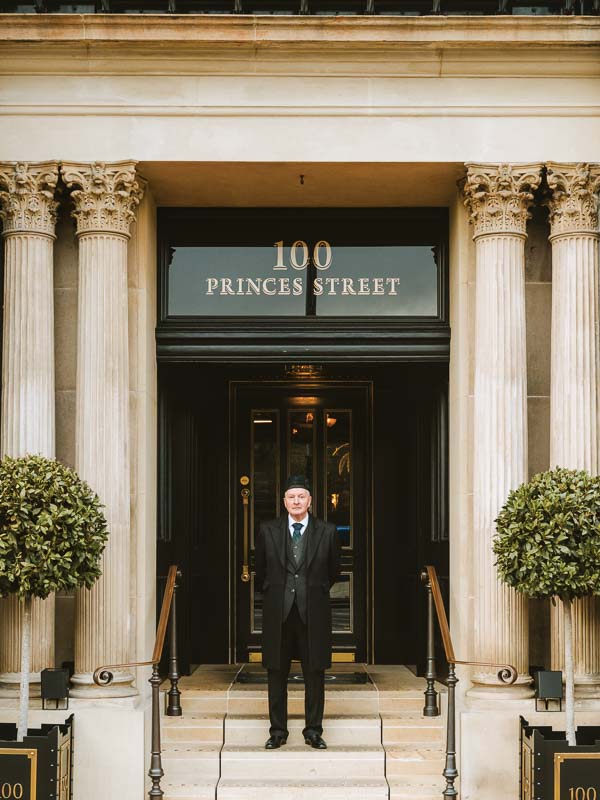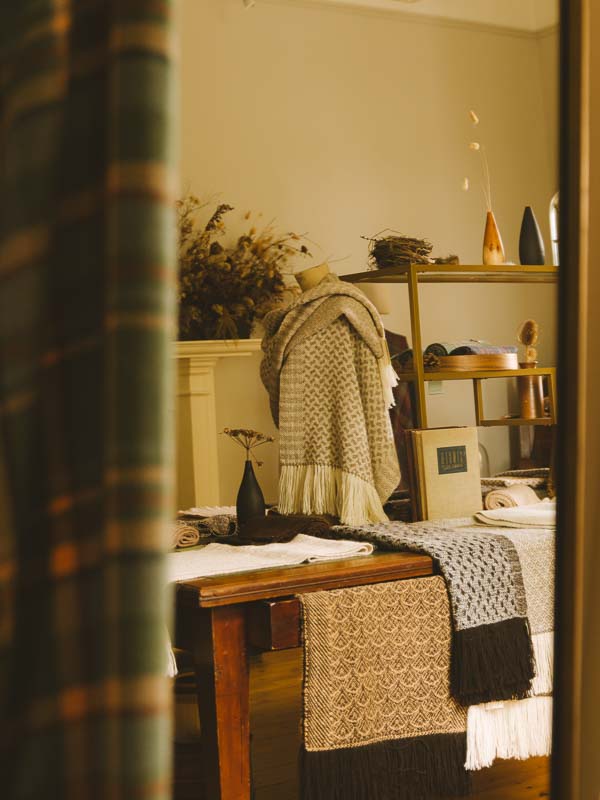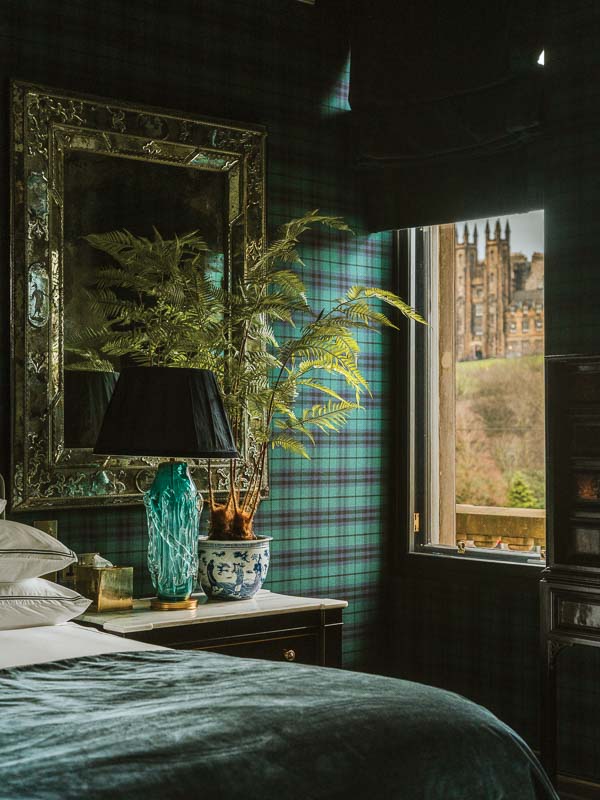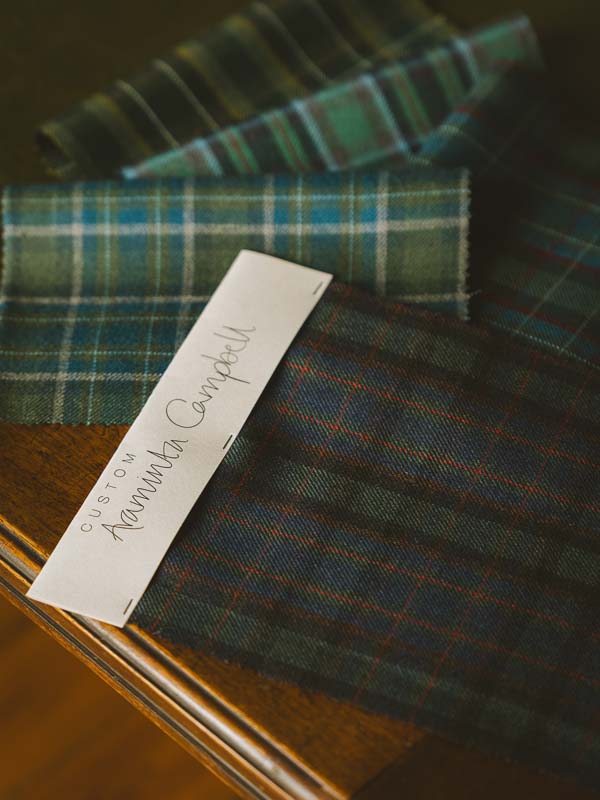A Visit to Araminta Campbell’s Atelier: Scotland’s Luxury Tartan and Tweed Experience
Guests at Edinburgh’s 100 Princes Street Hotel will spot Araminta Campbell’s bespoke tartans woven throughout the décor. In our magazine, we share the inside story of this collaboration—here, we take a closer look at her atelier and the traditions of tartan, tweed, and plaid.
________________________________________________________________________

While staying at the 100 Princes Street Hotel, guests will spot pieces from the beloved Scottish luxury brand Araminta Campbell’s collaborative collection woven throughout the décor.
Just outside the bustle of downtown Edinburgh sits the Araminta Campbell Atelier, a dignified building that conjures visions of jovial ballrooms, the echo of the harp and violin, and gravel crunching beneath horse-drawn carriages. Originally part of the stately Hopetoun Estate near South Queensferry, the baronial-style farmhouse was built in 1822. With its slated roofs, crenelated parapets, angle turrets, and pointed windows, the architecture is distinctly Scottish—a welcoming combination of comfort and grandeur.
Founded in 2016 by Araminta Birse-Stewart, the brand was inspired by the tartans of her childhood. She turned to weaving during university to capture Scotland’s beauty through “woven artworks” and storytelling by thread. Rooted in Scottish landscapes and traditions, the atelier produces exquisite handwoven textiles that reflect the creativity and craftsmanship of local artisans.

Araminta always imagined a dedicated space to invite guests to. Early on, she displayed her work at craft shows, but soon realized they couldn’t reflect the depth of craftsmanship or the stories behind her pieces. She began welcoming visitors into her Leith studio and dreamed of a rural setting connected to nature yet accessible—a hidden gem that feels special but within reach.
“Today, the atelier is both a destination and the heart of the brand, embodying [my] mission to place the craft of handweaving on the centre stage. . . .It has been thoughtfully transformed into a space that honours the heritage of the building while providing a home for contemporary craftsmanship,” Araminta explains.
Araminta worked closely with the Tollman family—the founders of the Red Carnation Hotel brand—and the hotel’s interior designer to develop five distinct tartans that reflect their heritage and vision. Bold green, navy, and red threads depict different facets of their story.
“For example, the Lourie Tartan, inspired by Mrs. Tollman’s maiden name, is a joyful celebration . . . echoing the warmth and generous spirit found in every Red Carnation property. The Tollman Tartan, crafted in honour of the family patriarch, features rich, moody hues of green, blue, and red, with fine checks of light blue symbolising clarity, strength, and deep-rooted leadership.”

The experience includes a luxury shopping visit to the atelier, a behind-the-scenes look at the weaving process, and a chance to meet Araminta. Each piece is made using centuries-old loom techniques and British alpaca. She incorporates ancient plant-dyeing methods to create hues that feel both modern and timeless. You can also commission a bespoke, heirloom-quality design unlike anything else in the world.
You don’t need Scottish ancestry, Araminta insists. “We are passionate about creating something meaningful for you. Our approach is inclusive and welcoming, and we love when people come to us wanting to tell their own story through textile design, something that can be treasured for generations.”

Tartan, Tweed, and Plaid: What’s the Difference?
In their most basic understanding, tweed is a fabric, plaid is a garment, and tartan is a pattern. Now, let’s uncover the layers.
Tweed, with roots in both Scotland and Ireland, is the simplest to define, as its meaning has stayed relatively unchanged for centuries. Traditionally, this rough, woven fabric was made from wool, and it was most often associated with “the working man” due to its durability and warmth. This utilitarian textile is typically woven using a twill or herringbone pattern and often features muted earth tones, inspired by the natural landscapes of Ireland and Scotland.
Getting more specific, both tartan and plaid originated in Scotland. Tartan is a pattern consisting of crossing horizontal and vertical bands in multiple colors. They typically have an identical pattern of stripes running vertically and horizontally, resulting in overlapping square grids, or setts. Specific tartans are often associated with specific clans, as they originated in more remote locations as a standard pattern created by a resident weaver using locally available dyes (often coming from vegetables). These patterns were used in a variety of garments, eventually becoming synonymous with various regional clans throughout Scotland.
The definition of plaid has evolved the most since its origination. “Plaid” first referred to a large, rectangular piece of woolen fabric that was worn draped over the shoulders as a type of cloak, and the term originates from the Gaelic word plaide, meaning “blanket.” Today, plaid is associated with Scottish-inspired patterns that consist of woven stripes that meet at 90-degree angles. Plaids do not always include identical patterns of stripes running both vertically and horizontally, and they can incorporate variations in color, size, and pattern of stripes; additionally, plaids are not necessarily tied to any symbolic meaning or specific clan.
The post A Visit to Araminta Campbell’s Atelier: Scotland’s Luxury Tartan and Tweed Experience first appeared on Bake from Scratch.
